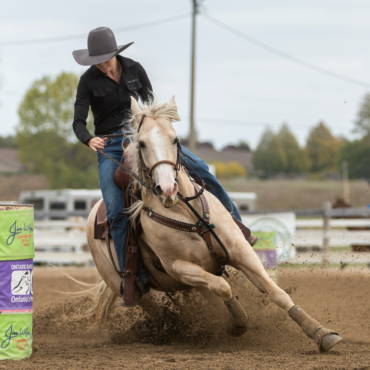Table of Contents
Control or Crutch? Asking “Does your horse need a tie down?”
Tack and equipment are a big part of training horses. Every horse and rider is different and we have many options to choose from.
Headgear, can be a controversial topic. While some view them as necessary, others argue that they are merely a crutch for training or underlying issues. Having experimented with different types of headgear, I understand both sides. This blog post will explore the truth about all types of headgear such as tie downs, bonnets, headsetters, discussing what they offer, how they work, and potential drawbacks for our barrel horses.
How do tie downs work
They are used to help control a horse’s head position, ensuring their head sits below the tiedown. But as Trevor Brazile notes, in his article here “Tie-downs are not built to be pushed on the whole time.” The goal is to create a clear boundary without limiting the horse’s natural movement.
It’s important to remember that misusing a tie down can cause more harm than good. By using a tie-down properly, riders can help their horses perform at their best without sacrificing comfort or freedom of movement.
Personal Experience: When I Found Tie-Downs Useful
Throughout my barrel racing journey, I’ve tried many different types of headgear. When riding a particularly chargey or hot horse, I found tie-downs offered a barrier that the bit didnt always provide, espeically when things happen so fast like in barrel racing.
I personally try to stay away from anything that restricts the movement of my horse. If I feel a need for a tiedown, before I just throw one on my horse I will ask a few questions first.
- could there be a underlying issue with my horse? What could it be? (example, teeth need to be done, they are body sore somewhere,
- Am I using the tiedown to fix a training issue
Tiedowns have a place in the tack room but not on every horse. It is our job to decide when it seems fitting to use a tie down and for what purpose.
Ask “does my horse need to become more stiff?” Then perhaps a leather tie down will improve your communication and create that wall for them to feel secure and stable and making them stiffer throughout their body.
“Does my horse toss their head anytime you use the reins?” Then maybe it’s time to understand your bits better and uncover the reason why your horse is tossing its head before you mask the behaviour with another tool.
The Pros of Using Tie-Downs
- **Easy to Use**: Tie-downs are simple to attach and adjust, making them beginner friendly to set up.
- **Instant Results**: You are instantly creating a boundary for their head. But be sure to teach your horse the new boundary before you get on.
- **Balancing Aid**: With a thicker leather noseband, tie-downs can give the horse something to lean against, helping maintain their balance.
The Cons of Tie-Downs: Potential Stiffness and Misuse
- **Causing Stiffness**: When a tie-down is too restrictive, it can lead to stiffness in a horse’s neck and shoulders. Imagine trying to run with your head held in an awkward position—it’s not comfortable for you, and it’s certainly not comfortable for your horse either.
- **Becoming Tense**: Over-reliance on tie-downs can encourage a horse to become bracey. Instead of responding smoothly to cues, they may push against the restriction, making their movement tense and jolty.
- **Risk of Pain**: Poorly fitted tie-downs can cause the horse pain. Whether it’s cuts or bruising, the wrong setup can do more harm than good. Always double-check your gear with someone who knows how to properly adjust a tiedown.
- **Fixing a Symptoms**: It’s tempting to use a tie-down as a quick fix for behavioral issues, but this doesn’t always mean youre fixing the root issue. Real improvement comes from a proper training foundation and clear communication.
- **Causing Anxiety**: A too-tight tie-down can make a horse feel trapped, leading to increased anxiety and tension. This added stress can cause a lot more issues in the arena.
By understanding these pros and cons, you can make more informed decisions about whether or not a tiedown is right for your horse.
Food for Thought
Horses communicate without the use of speech, therefore it is our job to listen to them in other ways. This is through our intuition, our energy, verbal cues, posture, body language and other hidden components to language horses respond to that we as riders can be unaware of.
At the end of the day, tools are simply tools. There isn’t one magic tool to make our horse perform how we want. It takes understanding how to communicate more effecively, becoming a more empathetic rider and being the horses leader to create healthy working realtionships.
It’s our job to educate the horse, if they aren’t educated then we have no one else to blame but ourselves. Use the tools, but don’t rely on them to do all the work.
When there are no shortcuts, there are also no holes.
While tie-downs can be a helpful tool in the barrel racing toolkit, they shouldn’t be your go-to solution for every problem. Remember, a solid training foundation will always outweigh any quick fix from equipment.


